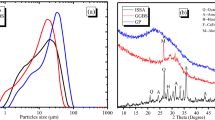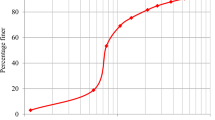Abstract
Utilizing waste materials in road construction has become a compelling alternative owing to the availability of high-quality natural aggregates and the challenges associated with disposing of industrial waste. This study delves into the potential of class F fly ash from coal combustion, which is not self-cementing, requiring additional activators for stabilization. Activators such as lime, ground granulated blast furnace slag (GGBS), and bottom ash were incorporated in diverse proportions. The experimental analysis included tests like modified Proctor compaction, unconfined compressive strength (UCS), California bearing ratio (CBR), and repeated load triaxial tests. Results revealed that the introduction of 1–3% lime, 3–21% ground granulated blast furnace slag, and 10–30% bottom ash, combined with extended curing durations, augmented both compressive strength and California bearing ratio values. The resilient modulus of these mixtures showed an improvement of roughly 70% compared to traditional Wet Mix Macadam. Advanced microscopic studies using X-Ray diffraction (XRD), field emission scanning electron microscopy (FESEM) equipped with energy dispersive spectroscopy (EDS), and thermogravimetric analysis (TGA) identified the formation of calcium silicate hydrates and ettringite as contributing factors to the increased strength. The optimally formulated mixtures met the requirements outlined by the Indian Roads Congress, suggesting their suitability for inclusion in base, subbase courses of flexible pavements, and the dry lean concrete layer of rigid pavements.
Graphical abstract

















Similar content being viewed by others
Data availability
The datasets generated and/or analyzed during the current study are available from the corresponding author on reasonable request.
References
AASHTO (2007) Determining the resilient modulus of soils and aggregate materials. AASHTO T-307
AASHTO (American Association of State Highway and Trans- portation Officials) (1993) Guide for design of pavement structures. Transportation Research Board, National Research Council, Washington, DC
APHA Publication, Washington D (1992) standard methods for the examination of water and wastewater, 23rd edn
ASTM Standard Specification for Coal Fly Ash and Raw or Calcined Natural Pozzolan for Use in Concrete. ASTM C618-22. https://doi.org/10.1520/C0618-22
ASTM (2015) Standard test methods for wetting and drying compacted soil-cement mixtures 1. ASTM D559. West Conshohocken, PA: ASTM International.
Allan ML, Kukacka LE (1995) Blast furnace slag-modified grouts for in situ stabilization of chromium-contaminated soil. Waste Manag 15:193–202. https://doi.org/10.1016/0956-053X(95)00017-T
BIS (2012) Indian Standard Drinking Water Specification (Second Revision). Bur Indian Stand IS 10500:1–11
Bakare MD, Pai RR, Patel S, Shahu JT (2019) Environmental sustainability by bulk utilization of Fly Ash and GBFS as road subbase materials. J Hazardous Toxic Radioact Waste 23:04019011. https://doi.org/10.1061/(asce)hz.2153-5515.0000450
Bijen J (1996) Benefits of slag and fly ash. Constr Build Mater 10:309–314. https://doi.org/10.1016/0950-0618(95)00014-3
Bureau of Indian Standards (1983) Determination of water content- dry density relation using heavy compaction. IS 2720 Part-VIII
Cho H, Oh D, Kim K (2005) A study on removal characteristics of heavy metals from aqueous solution by fly ash. J Hazard Mater 127:187–195. https://doi.org/10.1016/j.jhazmat.2005.07.019
Dhadse S, Kumari P, Bhagia LJ (2008) Fly ash characterization, utilization and government initiatives in India—a review. J Sci Ind Res (india) 67:11–18
Falayi T, Okona FN, Ntuli F (2016) The geotechnical and microstructural properties of desilicated fly ash lime stabilised expansive soil. Mater Struct 49:4881–4891. https://doi.org/10.1617/s11527-016-0831-7
Ghosh A, Subbarao C (2001) Microstructural development in fly ash modified with lime and gypsum. J Mater Civ Eng 13:65–70
Ghosh A, Subbarao C (2007) Strength characteristics of class F fly ash modified with lime and gypsum. J Geotech Geoenvironmental Eng 133:757–766. https://doi.org/10.1061/ASCE1090-02412007133:7757
Gong Y, Yang J, Sun H, Xu F (2021) Effect of fly ash belite cement on hydration performance of Portland cement. Crystals 11:1–10. https://doi.org/10.3390/cryst11070740
Hicks RG, Monismith CL (1971) Factors influencing the resil- ient properties of granular materials. Transp Res Rec J 345, Washington, DC 15–31
Hoy M, Nhieu DV, Horpibulsuk S et al (2023a) Effect of wetting and drying cycles on mechanical strength of cement-natural rubber latex stabilized recycled concrete aggregate. Constr Build Mater 394:132301. https://doi.org/10.1016/j.conbuildmat.2023.132301
Hoy M, Tran NQ, Suddeepong A et al (2023b) Wetting-drying durability performance of cement-stabilized recycled materials and lateritic soil using natural rubber latex. Constr Build Mater 403:133108. https://doi.org/10.1016/j.conbuildmat.2023.133108
IRC:37-2018 (2018) Guidelines for the design of Flexible Pavement—IV Revision. Indian Road Congr New Delhi, India
IRC:SP:20 (2002) Rural roads manual. Indian Road Congr New Delhi, India
IS (2020) Determination of unconfined compressive strength of stabilized soils. IS 4332 Part-V, New Delhi, India
IS (2010) Methods of test for stabillzed soils part IV wetting and drying, and freezing and thawing tests for compacted soil-cement mixtures. New Delhi, India, 2010 (Indian Standard)
Indian Roads Congress (IRC) (2002) Rural roads manual. IRC SP 20
Indian Roads Congress (IRC) (2010) Guidelines for soil and granular material stabilization using cement, lime & fly ash. IRC SP 89
Indian Roads Congress (IRC) (2014) Guidelines for the use of dry lean concete as subbase for rigid pavement. IRC SP 49
Izquierdo M, Querol X (2012) Leaching behaviour of elements from coal combustion fly ash: an overview. Int J Coal Geol 94:54–66. https://doi.org/10.1016/j.coal.2011.10.006
Jagad G, Modhera C, Patel D, Patel V (2023) Mechanical and microstructural characteristics of manufactured sand-based high-strength geopolymer concrete and its environmental impact. Pract Period Struct Des Constr 28:1. https://doi.org/10.1061/ppscfx.sceng-1308
Jha AK, Sivapullaiah PV (2016) Role of gypsum on microstructure and strength of soil. Environ Geotech 3:78–89
Jiang W, Roy DM (1992) Hydrothermal processing of new fly ash cement. Am Ceram Soc Bull 71:4
Joshi AR, Patel S (2023) Investigation into sustainable application of class C Fly ash layer in flexible pavement. J Hazardous, Toxic, Radioact Waste 27:1–11. https://doi.org/10.1061/(asce)hz.2153-5515.0000727
Jung SH, Saraswathy V, Karthick S et al (2018) Microstructure characteristics of fly ash concrete with rice husk ash and lime stone powder. Int J Concr Struct Mater. https://doi.org/10.1186/s40069-018-0257-4
Kedar HN, Patel S (2023) Complete replacement of granular base layer with stabilized fly ash for road construction. Indian Geotech J. https://doi.org/10.1007/s40098-023-00817-1
Kedar HN, Patel S, Shirol SS (2024) Bulk utilization of steel slag—fly ash composite : a sustainable alternative for use as road construction materials. Innov Infrastruct Solut. https://doi.org/10.1007/s41062-023-01325-0
Kumar Sharma A, Sivapullaiah P (2012) Improvement of strength of expansive soil with waste granulated blast furnace slag. In: GeoCongress 2012
Lav AH, Lav MA (2000) Microstructural development of stabilized fly ash as pavement base material. J Mater Civ Eng 80:157–163
Lynn J, Ghataora GS, Obe RKD (2019) ScienceDirect municipal incinerated bottom ash (MIBA) characteristics and potential for use in road pavements. Int J Pavem Res Technol 10:185–201. https://doi.org/10.1016/j.ijprt.2016.12.003
Mohammadinia A, Arulrajah A, Horpibulsuk S (2017) Effect of fly ash on properties of crushed brick and reclaimed asphalt in pavement base/subbase applications. J Hazard Mater 321:547–556. https://doi.org/10.1016/j.jhazmat.2016.09.039
NCHRP (National Cooperative Highway Research Program) (2003) Harmonized test methods for laboratory determination of resilient modulus for flexible pavement design. Final Rep. No. 1-28A. Washington, DC: NCHRP.
Narmluk M, Nawa T (2014) Effect of curing temperature on pozzolanic reaction of fly ash in blended cement paste. Int J Chem Eng Appl 5:31–35. https://doi.org/10.7763/ijcea.2014.v5.346
Newman J, Choo BS (2003) Advanced concrete technology. Constituent materials. Elsevier, Amsterdam
Pai RR, Patel S, Bakare MD (2020) Applicability of utilizing stabilized native soil as a subbase course in flexible pavement. Indian Geotech J 50:289–299. https://doi.org/10.1007/s40098-020-00432-4
Pal SK, Ghosh A (2013) Hydraulic conductivity of fly ash-montmorillonite clay mixtures. Indian Geotech J 43:47–61. https://doi.org/10.1007/s40098-012-0033-3
Pani A, Singh SP (2016) Effect of temperature on the strength of lime-stabilised fly ash. Environ Geotech 7:189–199. https://doi.org/10.1680/jenge.17.00050
Patel D, Kumar R, Chauhan K, Patel S (2021a) Using copper slag and fly ash stabilised with lime or cement as a road base material. Proc Inst Civ Eng Constr Mater. https://doi.org/10.1680/jcoma.18.00055
Patel S, Orlov A, Ariyachandra E, Peethamparan S (2021b) Effect of flue gas temperature on NO2 adsorption by aged recycled concrete waste: DRIFTS, TGA and BET study. Chem Eng J 420:130413. https://doi.org/10.1016/j.cej.2021.130413
Patel S, Shahu JT (2016a) Resilient response and permanent strain of steel Slag-Fly Ash-Dolime Mix. J Mater Civ Eng 28:04016106. https://doi.org/10.1061/(asce)mt.1943-5533.0001619
Patel S, Shahu JT (2016b) Resilient response and permanent strain of steel Slag-Fly Ash-Dolime Mix. J Mater Civ Eng 28:1–11. https://doi.org/10.1061/(asce)mt.1943-5533.0001619
Puppala AJ, Asce M, Hoyos LR, Potturi AK (2011) Resilient moduli response of moderately cement-treated reclaimed asphalt pavement aggregates. pp 990–998. https://doi.org/10.1061/(ASCE)MT.1943-5533.0000268.
Rada G, Witczak MW (1981) The universal airport pavement design system. Rep I V Granul Mater Charact Dep Civ Eng Univ Maryland, Coll Park MD
Rafieizonooz M, Mirza J, Razman M et al (2016) Investigation of coal bottom ash and fly ash in concrete as replacement for sand and cement. Constr Build Mater 116:15–24. https://doi.org/10.1016/j.conbuildmat.2016.04.080
Sahu V, Srivastava A, Kumar A (2016) Stabilization of fly ash and lime sludge composites: assessment of its performance as base course material. Arch Civ Mech Eng 17:475–485. https://doi.org/10.1016/j.acme.2016.12.010
Sahu V, Srivastava A, Misra AK, Sharma AK (2018) Synthesis and characterization of green composites: focus on accelerated strength, ductility and durability. Indoor Built Environ 27:630–644. https://doi.org/10.1177/1420326X16689293
Schilling PJ (1992) The Structure of Cementitious Materials Produced by Alkali Activation of Calcium Aluminosilicate Glasses. LSU Historical Dissertations and Theses. 5355. https://doi.org/10.31390/gradschool_disstheses.5355
Sharma AK, Sivapullaiah PV (2016) Strength development in fly ash and slag mixtures with lime. Proc Inst Civ Eng Gr Improv 169(4):297–305
Sharma NK, Swain SK, Sahoo UC (2012) Stabilization of a clayey soil with fly ash and lime: a micro level investigation. Geotech Geol Eng 30:1197–1205. https://doi.org/10.1007/s10706-012-9532-3
Sherwood PT (1993) Soil stabilization with cement and lime. HMSO, London
Singh A, Dhami HS, Sinha MK, Kumar R (2022) Evaluation and comparison of mineralogical, micromeritics and rheological properties of waste machining chips, coal fly ash particulates with metal and ceramic powders. Powder Technol 408:117696. https://doi.org/10.1016/j.powtec.2022.117696
Singh S, Ransinchung GDRN, Monu K (2019) Sustainable lean concrete mixes containing wastes originating from roads and industries. Constr Build Mater 209:619–630. https://doi.org/10.1016/j.conbuildmat.2019.03.122
Singh S, Ransinchung GDRN, Monu K, Kumar P (2018) Laboratory investigation of RAP aggregates for dry lean concrete mixes. Constr Build Mater 166:808–816. https://doi.org/10.1016/j.conbuildmat.2018.01.131
Singh R, Singh RK, Gupta NC, Guha BK (2010) Assessment of heavy metals in fly ash and groundwater—a case study of NTPC badarpur thermal power plant, Delhi, India. Pollut Res 29:685–689
Singh SP, Tripathy DP, Ranjith PG (2008) Performance evaluation of cement stabilized fly ash-GBFS mixes as a highway construction material. Waste Manag 28:1331–1337. https://doi.org/10.1016/j.wasman.2007.09.017
Sivapullaiah PV, Ali A, Moghal B (2011) Role of gypsum in the strength development of fly ashes with lime. J Mater Civ Eng. https://doi.org/10.1061/ASCEMT.1943-5533.0000158
USEPA (1992) Toxicity characteristic leaching procedure. USEPA Method 1311:1–35
Uzan J (1985) Characterization of granular material. Transp Res Rec 1022:52–59
Xu A, Sarkar SL (1994) Microstructural developement in high-volume Fly-AsH cement system. J Mater Civ Eng 6:117–136
Yao ZT, Ji XS, Sarker PK et al (2015) A comprehensive review on the applications of coal fly ash. Earth Sci Rev 141:105–121. https://doi.org/10.1016/j.earscirev.2014.11.016
Author information
Authors and Affiliations
Contributions
Hrushikesh N. Kedar involved in writing-original draft preparation, conceptualization, methodology, data curation. Satyajit Patel involved in writing-original draft preparation, supervision, reviewing and editing
Corresponding author
Ethics declarations
Competing interests
The authors declare no competing interests.
Additional information
Publisher's Note
Springer Nature remains neutral with regard to jurisdictional claims in published maps and institutional affiliations.
Rights and permissions
Springer Nature or its licensor (e.g. a society or other partner) holds exclusive rights to this article under a publishing agreement with the author(s) or other rightsholder(s); author self-archiving of the accepted manuscript version of this article is solely governed by the terms of such publishing agreement and applicable law.
About this article
Cite this article
Kedar, H.N., Patel, S. Effect of hydraulic binders on engineering properties of coal ash for utilization in pavement layers. Clean Techn Environ Policy (2024). https://doi.org/10.1007/s10098-024-02800-7
Received:
Accepted:
Published:
DOI: https://doi.org/10.1007/s10098-024-02800-7




